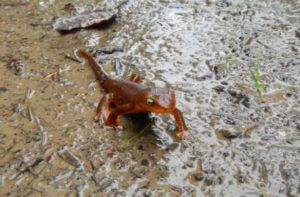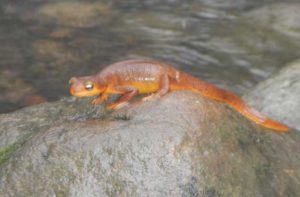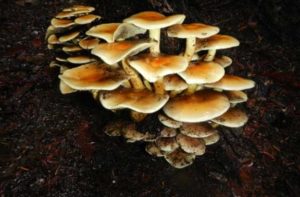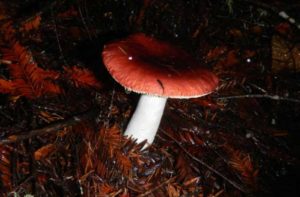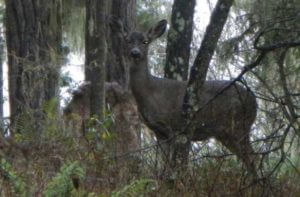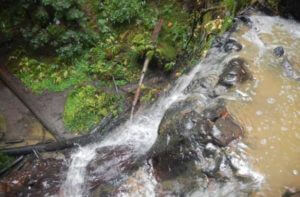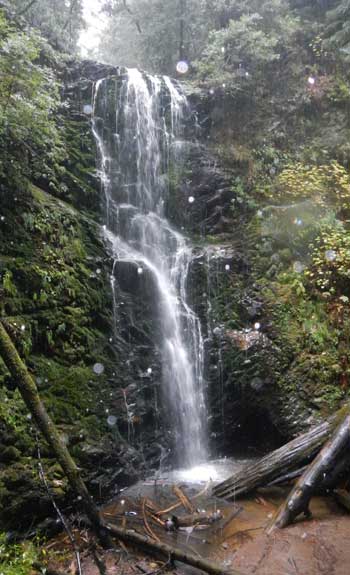Rain Sorcery: A Wyrd Hike with Newts
- (Photo Credits: Ryan Masters)
By Ryan Masters, Sempervirens Fund
(Originally published Nov. 26, 2014 in Hilltromper)
The eyes of a California Newt are black slits set into saffron orbs. Gaze into them and you will know why the trio of weird sisters in Macbeth treasured them for their cauldron. They are gnomish and implacable. They hold secrets only found beneath glistening fern fronds and the oozing crowns of fungi. And if you are lucky enough to encounter hundreds at a time during a rainstorm, you will know their newt sorcery.
On a witchy, late November morning, I set out in a steady rainstorm from Waddell Beach. My plan was to hike to the waterfalls—Berry Creek, Silver and Golden—in Big Basin Redwoods State Park and witness the season’s first heavy rain roar through the trio of cataracts. At roughly 13 miles round trip, it’s a healthy trudge in bad weather, so I left early, hoping the rain would taper off by midday.
As in the beginning of Shakespeare’s play, the weather was murky at the outset of my hike. In fact, the marshes surrounding Rancho del Oso, where Waddell Creek drains to the sea, could easily double for the Scottish heath where Macbeth and Banquo stumble upon the weird sisters. A hard rain fell and banks of fog hovered in the valley like wispy ghosts of erupted Zeppelins. Old oaks with beards of Spanish moss grasped at the mist with gnarled arms. Motionless black-tailed does watched me pass along the trail with wide, cautious eyes, their sleek bodies poised to bolt deep into the woods like Diana’s nymphs.
To quote the weird sisters, “Fair is foul and foul is fair” on rainy days in Big Basin. Although the weather obscures the sweeping vistas of skyline and sea, by default it draws an odd, more intimate beauty into sharp focus. You become intensely aware of the silence, the dripping rain, the microcosm of the path.
This morning, California Buckeye littered the trail, their velvety pods peeled back to reveal shiny, chestnut-colored seeds the size of racquetballs. The land’s original alchemists, the Ohlone, ground up these orbs for use in a particularly effective spell—to stun fish in streams with poisonous tannins. Mushrooms erupted from the rich mulch of decaying leaves, their globular domes sticky with the essence of fragrant California Bay, arching Red Alder and Monterey Pine. Covered in a fine shroud of mucus, a banana slug slurped across a redwood’s talon roots. The fluorescent hermaphrodite waved its upper eyestalks like wands as it crawled, sensing light and movement—while its lower eyestalks sniffed the dank ground for pleasing chemicals.
As the trail fell in step alongside Waddell Creek’s mud-choked waters, I noticed movement on the wet carpet of maple leaves. At first they blended seamlessly with the autumnal colors. Then one of the moist creatures curled away from the toe of my boot, displaying a flash of its bright-orange underbelly. Suddenly I saw them everywhere. California Newts. They scurried with the speed and intensity of melting wax and flopped out of harm’s way. Some stood their ground and stared me down with cloven eyes. Others bathed in the rivulets of rainwater running down the trail, oblivious to my approach. My progress slowed considerably as I carefully stepped around them.
The California Newt has a scientific name that sounds like an incantation: Taricha torosa torosa. They are spellbinding little beasts—and surprisingly deadly. The glands in their slimy skin secrete the potent neurotoxin tetrodotoxin, which is also found in pufferfish and harlequin frogs. Hundreds of times more toxic than cyanide, it’s strong enough to kill most vertebrates, including humans—but only if ingested. So, as a general rule, try to restrain from eating one. I came across a newt glarping down a fat, gray worm. Kneeling on the trail, I watched with grim fascination as it consumed its writhing prey. Due to its toxicity, the California Newt has few natural predators. This one appeared to be daring me to interfere with his wormy meal. Unsettled by the spectacle, I continued on my way.
* * *
I did not see another soul on the trail for the entire hike. Hiking in solitude through the rain, you are beholden to the voice in your head. Hiking in solitude through a mass of squirming newts, you are beholden to the same word over and over as you spot them. “Newt…newt…newt…” You must sidestep, step over and dance around them. “Newt…newt…newt.” For miles, you must concentrate on placing your boot in a spot not occupied by a newt. “No newt…no newt…no newt.” Eventually your brain begins to see newts where no newts exist. “Newt…newt…newt…” You realize you will probably be dreaming about newts for the next month. “Newt…newt…newt…” When you step off the deserted trail to urinate, you half-expect to find a newt in your trousers. “Newt?” As you bushwhack into the undergrowth to inspect spectacular eruptions of mushrooms, newts scatter in all directions like flat-footed basilisks. “Newt…newt…newt…” Before long, the word began to lose meaning and there is only newt…newt…newt.
Only when I branched off Waddell Creek at the head of the Sunset Trail, which tracks Berry Creek’s route down from the waterfalls, did the newt spell finally lift. It was a relief. After hours of disquieting newt silence, the sound of Berry Creek Falls was like a song. The days of heavy rain had done their magic and water coursed off the cliff in a shimmering 65-foot curtain. It was a joy to sit on the viewing deck by myself and take in the rain, the falls, the moisture soaking into the forest around me—free from the baleful gaze of any newts. It has been a long drought. I sensed the vegetation soaking up all the water and bulging with renewed life.
The San Francisco Renaissance poet William Everson spent much of his life in Big Creek Canyon, a ridge or two over from where I stood. In his brilliant book Masks of Drought, he meditates on the effects of the 1976-1977 drought and the force of God that is the first big storm of the season. In his poem “Runoff,” Everson conjures the female spirit of these menstrual rains: “Leaves like dead cells/Long held back in the frigid womb/Begin now to flow—under the rain/A deep cleansing, this rite of renewal.”
Everson spent two decades as a Dominican Friar, answered to the name Brother Antoninus and established himself as a literary and countercultural hero. In 1969 the man had a sexual awakening, cast off his robes in a public performance, married a much younger woman and began incorporating what he learned into his work. These lines, which describe the salmon waiting on the rains to gush out of the Santa Cruz Mountains and into the Pacific Ocean, are a wonderful example:
Beyond the slant sandbar blocking the rivermouth,
The great grey salmon skulked in the trough, dreaming the long
Genetic dream, plasmatic slumber of the unfulfilled,
Awaiting the moment of the forth-showing,
The river-tongue in the sea’s vulva,
The strength in the slot.
(from “Storm-Surge,” Masks of Drought)
It’s a gorgeous, sensual image and brings me back to the weird sisters. The word “weird” comes from the Old English term “wyrd,” meaning “fate.” Shakespeare was probably using the witches as stand-ins for the three Fates of classical mythology. Since the Fates control man’s destiny, calling them “weird” was the Bard’s way of indicating that Macbeth doesn’t have any control over his actions, and that his choices aren’t really his to make. I can relate.
When I was a young man, I believed I was the master of my own destiny. However, as I grew older I felt less like a powerful steelhead swimming upstream to some agreed-upon reward and more like one of those blind albino fish foundering about in a lightless cave. I’ve come to understand that, like Everson’s salmon, one must simply have patience—and faith. You cannot will the rains to end the drought.. They will simply come when they are meant to come. What once seemed like powerlessness to me, I now recognize as power.
Apparently it was my fate to continue up the trail another half-mile to Silver Falls and Golden Falls. The two cascades are so close together they can easily be mistaken for a single complex of waterfalls. After skirting the roaring base of Silver Falls, the trail winds its Tolkienian way up the misty face of the limestone cliff before teetering around at its edge. I paused here and enjoyed the dizzying view back down on the pool five stories below. Redwood trunks, long ago felled by some storm, lay crisscross at the base of the waterfall like some monumental game of pick-up sticks.
As I stood at the precipice, the rain stopped and the sun came out. Every drop of moisture in the forest seems to dazzle and sparkle in the bright, foreign light. Somewhere overhead, a blue jay ventured a jeer. It was an astounding moment. And then, on the earthen bank beside me, I sensed a squirm of movement beneath a fern.
Newt.
________________________________________
Read about the California Newt at Hilltromper.com.
